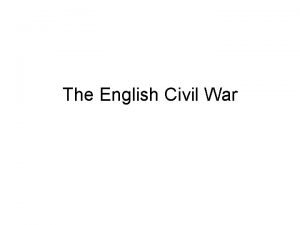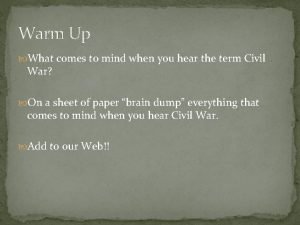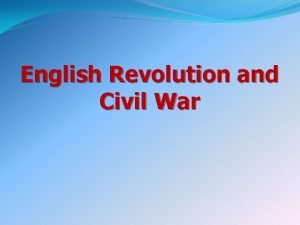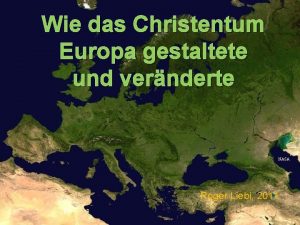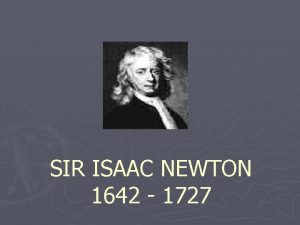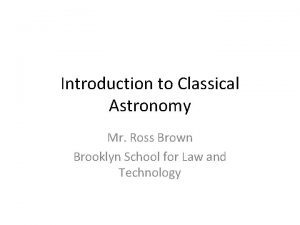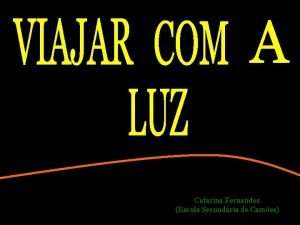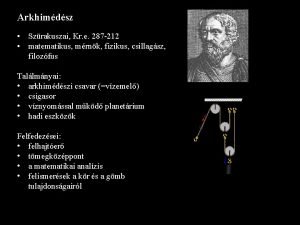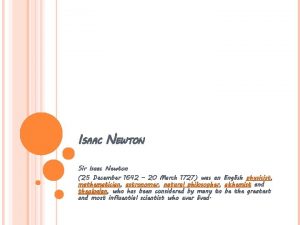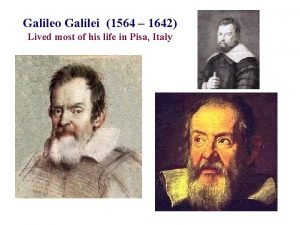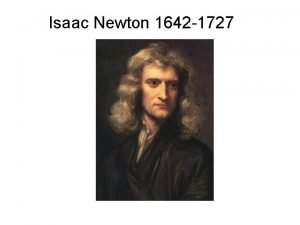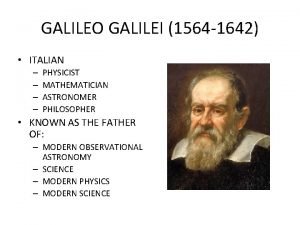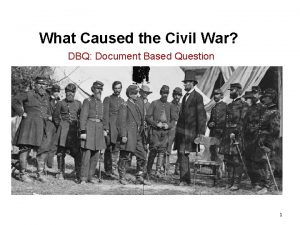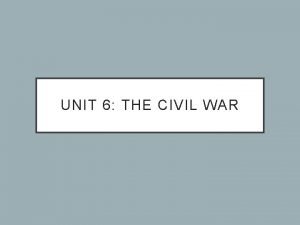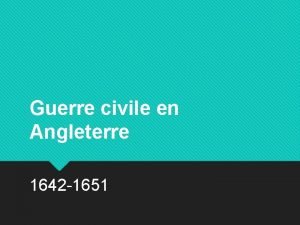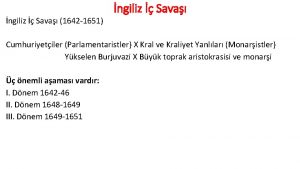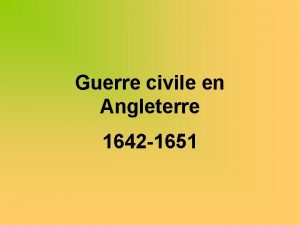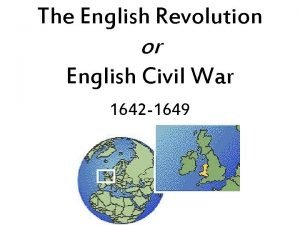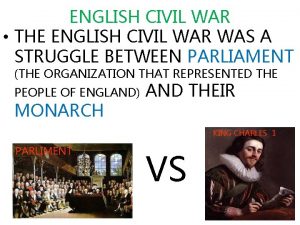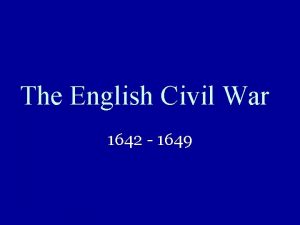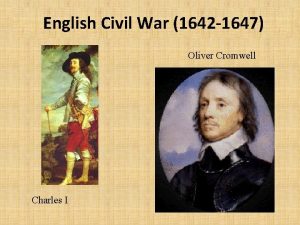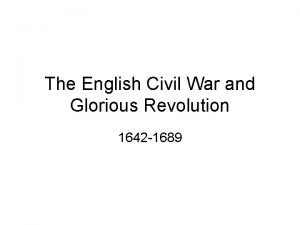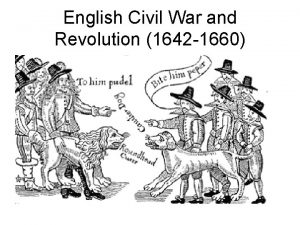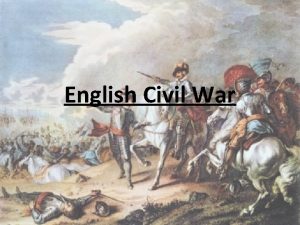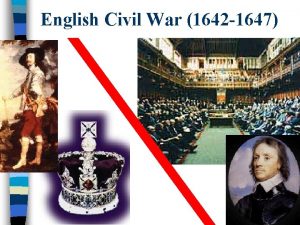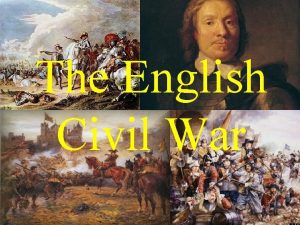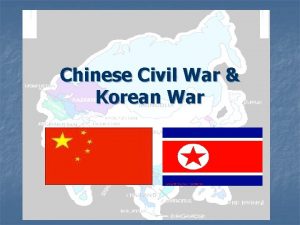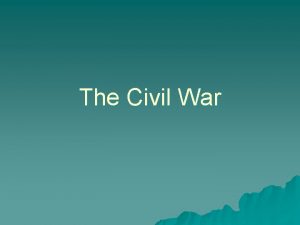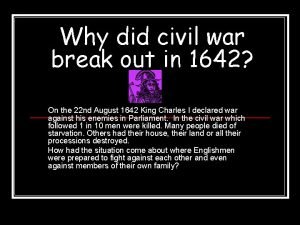The English Civil War 1642 1651 End of























- Slides: 23

The English Civil War 1642 -1651

End of Tudor Rule • In 1603 Elizabeth 1 dies • She died without an heir • This official ends the Tudor dynasty • Closet living heir was James VI of Scotland • Mother was Mary Queen of Scots, cousin to Elizabeth I • He assumes the throne and becomes James I of England


James I (1603 -1625) • First in Stuart Dynasty • Personal Union of Scotland England: England Scotland not one country, but both governed by same person • Justified his reign based on divine right • believed he was God’s representative on Earth • believed judges were agents of the king, not servants of the law • Parliament rarely called when James I was in power • True Law of Free Monarchies (1598) (argued monarchs are free from parliament control

• Twice dissolved Parliament over taxations and demands for free speech • Flaunted his wealth and damaged the image/ prestige of the monarchy • England was in debt due to a series of wars during Elizabeth's reign


Charles I (1625 -1642) • Personal: • son of James I • great supporter of the arts • known to be vain • Politics • believed in divine right monarchy • attempted to rule as an absolute monarch

Charles I v. Parliament • Charles and Parliament argued over the issue of taxation • Charles needed money for war. • To save money, soldiers were quartered in English homes during wartime (this was very unpopular). • Some English nobles were arrested for refusing to lend money to the government. • By 1628, both houses of Parliament were firmly opposed to the king.

Petition of Right (1628) • Parliament attempted to encourage Charles to grant basic legal rights in return for granting tax increases. • Provisions: • • • Only Parliament had the right to levy taxes No one should be imprisoned without due process of law All had the right to habeas corpus No forced quartering of soldiers in homes of private citizens Martial law could not be declared in peacetime

• In response Charles dissolved Parliament in 1629 • Parliament continued to refuse increased taxation without its consent. • Parliament also had demanded that any movement of the gov’t toward Catholicism be treated as treason.

Charles Rule Without Parliament • Charles ruled as an absolute monarch during these 11 years. • Raised money using medieval forms of forced taxation (those with wealth had to pay) • “Ship money”: all counties now required to pay to outfit ships where before only coastal communities had paid • Religious persecution of Puritans became the biggest reason for the English Civil War

The “Short Parliament” 1640 • Scottish military revolt in response to Charles’ attempt to impose the English Common Book of Prayer on the Scottish Presbyterian church • Charles needed new taxes to fight the war against Scotland. • Parliament reconvened in 1640 but refused to grant Charles new taxes if he did not accept the Petition of Rights and church reforms. • Charles disbanded Parliament again (after only 1 month).

The “Long Parliament” (1640 -1648) • Desperate for money after the Scottish invasion of northern England in 1640, Charles finally agreed to certain demands by Parliament. • Parliament’s demands: • Parliament could not be dissolved without its consent. • Parliament must meet at least once every three years • Ship money was abolished

• Those who persecuted Puritans were to be tried and executed • The Star Chamber was abolished. • Common law courts were supreme to the king’s courts. • Refused funds to raise an army to defeat the Irish revolt • Puritans became the majority in Parliament against the Kings Anglican supporters

The English Civil Wars (1642 -1649) • Immediate Cause • Charles tried to arrest several Puritan MPs but a crowd of 4, 000 came to its defense. • An Irish rebellion had broken out and Parliament was not willing to give the king an army. • March 1642, Charles declared war against his opponents in Parliament. • Civil war resulted

Cavaliers • supported the king • Clergy and supporters of the Anglican Church • Majority of the old gentry (nobility); north and west • Eventually, Irish Catholics (who feared Puritanism more than Anglicanism

Roundheads • opposed the king • • Consisted largely of Puritans (Congregationalists) and Presbyterians (who favored the Scottish church organization) Allied with Scotland (in return for guarantees Presbyterianism would be imposed on England after the war) • Supported by a majority of businessmen • Included some nobles in the south and east • Had the support of the navy and the merchant marine


Oliver Cromwell and the New Model Army • Charles surrendered to the Scots in 1646 and convinced them to invade England to restore him to the throne. • A division between Puritans and Presbyterians (and non-Puritans) developed late in the war. • Cromwell refused Parliament’s call to disband the army. • Parliament ordered the army to disband; Cromwell refused. • Cromwell successfully thwarted a Scottish invasion (Charles I had promised Scotland a Presbyterian system if they would help defeat Cromwell).


Pride’s Purge (1648) • Parliament debated restoring Charles I to the throne. • The New Model Army (without Cromwell’s knowledge) removed all non-Puritans from Parliament leaving a “Rump Parliament. ” • The “Rump” put Charles I on trial for treason. • Charles I was beheaded in 1649. • Effectively ended the English Civil War • First European king to be executed by his own subjects

The Protectorate (1653 -1659) • Cromwell became Lord Protector (in effect, a Puritan dictatorship) • Dissolved the “Rump Parliament” in 1653 after a series of disputes • England was divided into 12 districts, each under the control of a military general • Denied religious freedom to Anglicans and Catholics • Allowed Jews to return to England in 1655

End of the Commonwealth • Cromwell’s demise • Cromwell’s policies grew increasingly unpopular and England faced mounting financial problems • Cromwell died in 1658 (urinary infection) • Cromwell’s son Richard became “Lord Protector” from 1658 -59 • Richard lacked credibility with the army • Richard unable to deal with the Commonwealth’s financial problems • • Commonwealth collapsed in 1660 • Stuart dynasty restored by Parliament • Charles I’s son Charles II returned from France to become king • NOTE: after 1660, Commonwealth known as the “Interregnum”
 Why was the civil war the first modern war
Why was the civil war the first modern war Chapter 16 lesson 2 challenges to slavery
Chapter 16 lesson 2 challenges to slavery English civil war timeline
English civil war timeline English civil war mind map
English civil war mind map Causes of the english civil war
Causes of the english civil war Chapter 30 the war to end war
Chapter 30 the war to end war Chapter 30 the war to end war
Chapter 30 the war to end war Roger liebi ehefrau
Roger liebi ehefrau Que es ciencia
Que es ciencia (1642-1727)
(1642-1727) (1642-1727)
(1642-1727) (1642-1727)
(1642-1727) Kr e 287
Kr e 287 25 december 1642
25 december 1642 1642-1564
1642-1564 Louis braille biography
Louis braille biography Isaac newton 1642-1727
Isaac newton 1642-1727 Ital astrologe 1642
Ital astrologe 1642 Brujula bilancetta de galileo galilei
Brujula bilancetta de galileo galilei In 1642 columbus sailed the ocean blue
In 1642 columbus sailed the ocean blue Civil rights and civil liberties webquest
Civil rights and civil liberties webquest Causes of the civil war dbq
Causes of the civil war dbq Civil war map activity
Civil war map activity Causes of the civil war
Causes of the civil war


